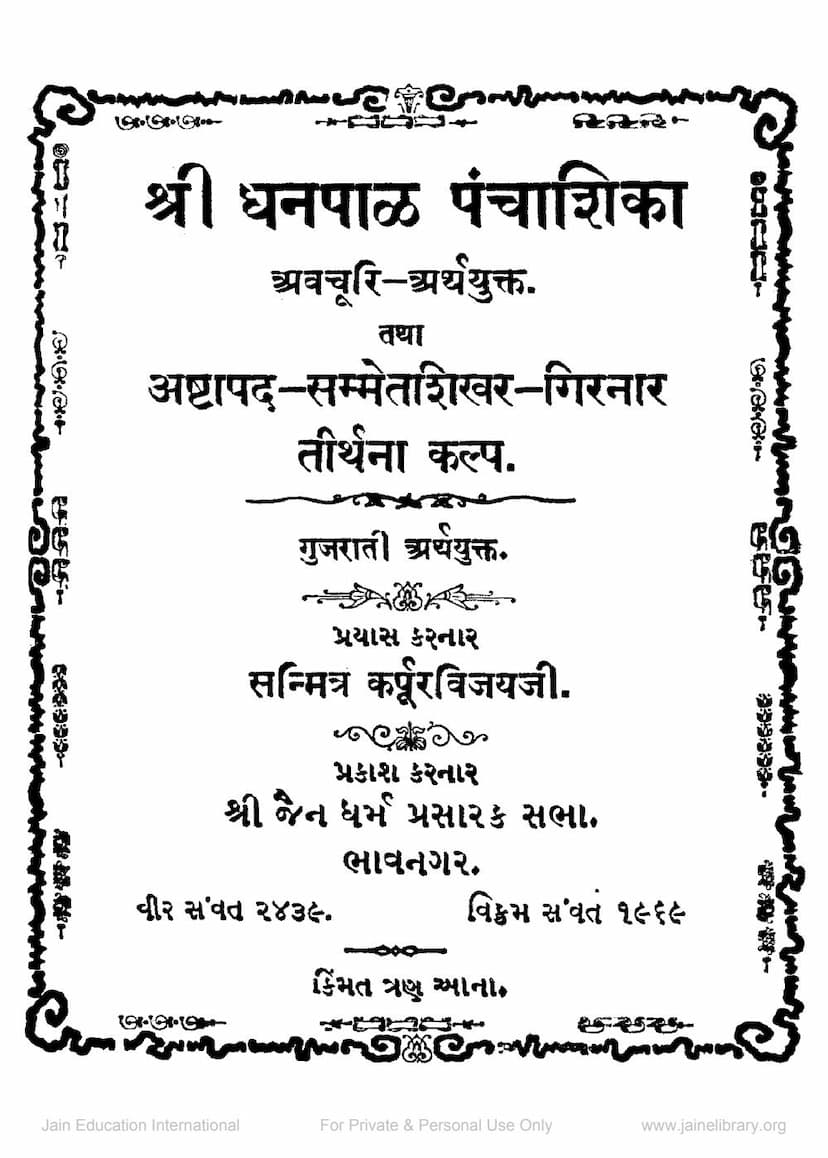Dhanpal Panchashika
Added to library: September 1, 2025

Summary
Here's a comprehensive summary of the Jain text "Dhanpal Panchashika" based on the provided pages:
The book "Dhanpal Panchashika" by Karpurvijay, published by Shri Jain Dharm Prasarak Sabha, Bhavnagar, in Veer Samvat 2439 and Vikram Samvat 1998, presents the "Dhanpal Panchashika" (also known as "Rishabh Panchashika") with an introductory commentary (Avchuri) and Gujarati translation. The book also includes "Kalpa" (narratives or descriptions related to the sanctity) of Ashtapad, Sammed Shikhar, and Girnar Tirth, along with their Gujarati translations.
Key Highlights and Content:
- Significance of Dhanpal Panchashika: Despite its small size, the "Dhanpal Panchashika" is highlighted as a work of great importance. The author, Dhanpal, was a highly respected scholar in the court of King Bhoj. His work received high praise from Shri Hemchandracharya, known as the "Kalkal Sarvajna" (Omniscient of the Kali Yuga).
- Hemchandracharya's Testimony: The introduction narrates an anecdote where King Kumarpal, during a pilgrimage to Siddhachal with Hemchandracharya, requested a hymn in praise of Rishabhdev. Hemchandracharya recited Dhanpal's "Panchashika." When Kumarpal asked why he was reciting another's work, Hemchandracharya explained that Dhanpal's composition was of such caliber that he himself could not replicate it. This anecdote underscores Dhanpal's scholarly prowess and spiritual devotion.
- Dhanpal's Life and Conversion:
- Dhanpal and his brother Shobhan hailed from Vishalpur. Their father, Sarvadev, was a Jain Brahmin.
- Facing poverty, Sarvadev sought help from Shri Vardhamanasuri, who revealed the location of hidden wealth. In return for his guidance, the Acharya requested one of Sarvadev's sons. Shobhan agreed to become the Acharya's disciple.
- After Sarvadev's death, Shobhan embraced Jainism, became a disciple, and achieved great scholarship.
- Dhanpal, due to his brother's departure, developed animosity towards monks. He became a renowned scholar in Dharanagari, serving King Bhoj. Driven by his hatred, he instigated a ban on monks' activities throughout Malwa for twelve years.
- Eventually, at the insistence of the Dharanagari Sangh, Acharya Shobhan Muni was sent to reason with Dhanpal. Upon their encounter, Dhanpal was initially swayed by Shobhan Muni's words.
- A turning point occurred when Dhanpal observed Shobhan Muni meticulously showing him the presence of microscopic creatures (Trasa Jiva) in curd, which led to his interest in Jain philosophy. Shobhan Muni then taught him the tenets of Jainism, leading to his firm conversion and becoming a steadfast Shravak (lay follower).
- Dhanpal's Influence on King Bhoj:
- Dhanpal demonstrated his deep understanding of Jain principles through various interactions with King Bhoj.
- He correctly answered complex riddles and prophecies, such as predicting which gate the king would exit from.
- When sent to worship deities, he chose to worship Lord Shantinath, explaining his devotion to the true divine, who is free from imperfections and capable of bestowing true salvation. He eloquently articulated that worship should be directed towards a divine being with all faculties, not one that is incomplete or incapable.
- His poetic brilliance and philosophical arguments deeply impressed King Bhoj, earning him a prestigious position among the scholars.
- The Incident with the "Rishabhdev Charitra":
- When King Bhoj inquired about Dhanpal's current work, Dhanpal revealed he was composing a "Rishabhdev Charitra" (Biography of Rishabhdev).
- King Bhoj, upon hearing a portion, requested changes: inserting his own name as the protagonist, Avanti instead of Ayodhya, and Mahakal temple instead of Shakravatar Tirth.
- Dhanpal steadfastly refused, comparing the requested alteration to comparing glass with diamonds or dhatura with the Kalpavriksha, highlighting the impossibility and inappropriateness of the suggestion.
- Enraged, King Bhoj burnt Dhanpal's original manuscript.
- Dhanpal's daughter, Tilakamanjari, who had heard the work read once, managed to have it rewritten, saving Dhanpal from despair.
- To commemorate his daughter's role, Dhanpal renamed the work "Tilakamanjari." However, the introduction notes that the original composition was likely about Rishabhdev, given the reason for its destruction.
- Other Works and Time Period: Dhanpal lived in the 11th century. While the "Panchashika" and "Tilakamanjari" are mentioned, other works like "Shravak Vidhi Prakaran" are rumored but not currently available.
- The "Panchashika" and its Commentary: The book includes the original Sanskrit verses of the "Panchashika" with a commentary (Avchuri). The commentary clarifies the meaning of each verse, often providing detailed explanations and analogies. The introduction emphasizes that only those who read with "Sardha Laksh" (attentive devotion) can truly grasp its profound meaning and power.
- The "Kalpas" of the Tirthas:
- Ashtapad: This section describes Ashtapad mountain, a sacred site where many souls, including Rishabhdev's descendants and ascetics, attained liberation. It details the numerous temples, idols, and spiritual activities that took place there.
- Sammed Shikhar: This part highlights Sammed Shikhar as a holy mountain, visited by Rishabhdev and numerous other Tirthankaras and saints. It emphasizes the spiritual significance of this pilgrimage site, where many attained liberation through asceticism and devotion.
- Girnar: The narrative for Girnar describes its sanctity, particularly in relation to Lord Neminath. It recounts his renunciation, the establishment of various temples and idols by kings and divine beings, and the continuing spiritual practices performed there.
- Publisher's Note: The Shri Jain Dharm Prasarak Sabha expresses gratitude to Muni Shri Karvijayji for his efforts in purifying the original texts and writing the meanings. They urge readers to treat the book with respect and engage in its study.
In essence, the book provides a detailed exposition of the "Dhanpal Panchashika," celebrating the life, conversion, and spiritual prowess of Dhanpal, a significant Jain scholar. It also offers devotional narratives about the revered Jain pilgrimage sites of Ashtapad, Sammed Shikhar, and Girnar, highlighting their historical and spiritual importance.